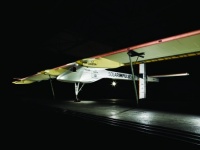Solar Impulse aims for 24 hour flight
Following six years of development, the Solar Impulse HB-SIA is said to have the potential to become the first manned solar aircraft to fly continuously through the day and night.

Andre Borschberg has particularly good reason for ensuring that the strange-looking aircraft currently housed in a hangar on the outskirts of Zurich is sturdy and safe enough to fly in.
That’s because when it takes to the sky next year in an effort to become the first manned solar aircraft to fly continuously through the day and night Borschberg — or his partner in the project, Swiss balloonist Dr Bertrand Piccard — will be sitting in the cockpit.

Unveiled earlier this summer, and due to make its maiden test-flight next month, the Solar Impulse HB-SIA is the result of six years of intense design and development and, its developers hope, the fore-runner to a follow-on solar aircraft that will circumnavigate the world.
Covered in 200m2 of solar cells, boasting a wingspan of 61m (the same as an Airbus A340) and weighing just 1,600kg, the aircraft is, claimed Borschberg, at least five times lighter than a high-performance glider of equivalent size.
Able to take off under its own power at a speed of 35km/h, it has an average flying speed of 70km/h and a maximum altitude, owing to an unpressurised cockpit, of 27,900ft (8,500m).
Its 12,000 silicon solar cells, supplied by US firm Sunpower, are each 150 microns thick and have a conversion efficiency of 22 per cent. These are not the most efficient cells on the market, but they are among the lightest, and weight, explained Borschberg, is everything. He said: ‘We are fighting everywhere to save some grams. We have used extremely thin layers of carbon composite for the major parts… and worked with [project partner] Solvay to find lighter materials, such as special foam for insulating the gondolas and cockpit.’ He added that the design team has even optimised the amount of glue used in the quest for weight savings.
Register now to continue reading
Thanks for visiting The Engineer. You’ve now reached your monthly limit of premium content. Register for free to unlock unlimited access to all of our premium content, as well as the latest technology news, industry opinion and special reports.
Benefits of registering
-
In-depth insights and coverage of key emerging trends
-
Unrestricted access to special reports throughout the year
-
Daily technology news delivered straight to your inbox










UK Enters ‘Golden Age of Nuclear’
Anybody know why it takes from 2025 to mid 2030's to build a factory-made SMR, by RR? Ten years... has there been no demonstrator either? Do RR...